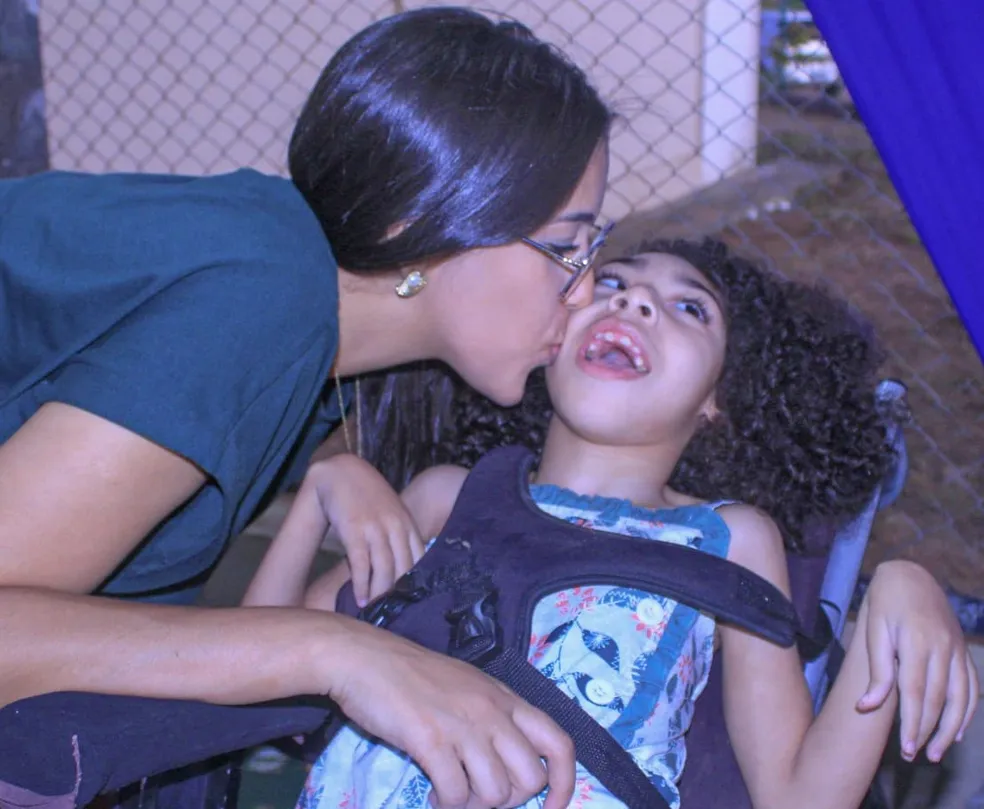In 2015, months before the Zika epidemic was officially declared in Brazil, Adalgisa Figueiredo, resident of São Gonçalo do Amarante (RN), experienced a moment of insecurity and vulnerability that would be part of the reality of thousands of people in the coming months: her daughter, Emilly, had been diagnosed with Congenital Zika Virus Syndrome. It was at that moment that Adalgisa, who was already the mother of a two-year-old child, needed to understand a reality that is still little known in many aspects of care, both for family members and health professionals, with regard to development, quality of life and well-being of children who, like Emilly, were born with the condition.
According to the Ministry of Health, Congenital Zika Virus Syndrome comprises a set of congenital anomalies that may include visual, auditory, urinary, evacuatory and neuropsychomotor changes that occur in individuals (embryos or fetuses) exposed to Zika virus infection during pregnancy.
Among these changes, the most visible is microcephaly, a malformation in which the newborn's head is smaller than expected. The Syndrome was noticed in 2015, as a result of changes in the occurrence patterns of microcephaly that occurred in Brazil, which led the country to declare a Public Health Emergency of National and, later, International Importance.
According to the Ministry of Health, in 2015, the year the Zika Virus epidemic began, 2,975 cases of microcephaly resulting from Congenital Syndrome were reported in 656 municipalities in 20 Brazilian states, most of them in the Northeast Region. The number was 20 times higher than the average number of microcephaly cases recorded in the previous 15 years (2000 to 2014), which until then was 150 babies born with the condition per year.
After the diagnosis, Adalgisa needed to change the way she saw her daughter's development. The universal vision of development, with rigid standards and pre-defined scales, did not fit into Emilly's reality. With the correct monitoring, however, she soon realized that there was a world of particularities and potentialities to be understood and incorporated into her daughter's trajectory. .
“Every little improvement, which for other children would seem like nonsense, for her is a lot and, for me, it is a big step forward. Her every development is a happiness, a pride. It represents for us a return that we received from the search for therapy and the effort, both mine and those of the professionals who care for her”, says Adalgisa.
Currently, Emilly is monitored by a multidisciplinary team at the Santos Dumont Institute (ISD), in Macaíba (RN). One of the most worked on aspects and which, according to the mother, showed a notable evolution, is the functioning of the bladder and intestine which, for children with congenital syndrome, can present changes, due to dysfunctions called Neurogenic Bladder and Bowel.
“Before, she wouldn’t drink a drop of water, she didn’t like it at all. Nowadays, she already drinks half a liter to 700ml. We have a goal for it to reach liters per day. We are trying, one day at a time. This is also part of what I learned: there is no point in setting a very high goal, unrealistic for the child. Development is a slow thing indeed. Often, these are details that we see and that, over time, reveal the change and evolution of the child”, he points out.
Adalgisa and Emilly, from the moment of diagnosis, follow a path to re-signify the notions of child development based on the needs and potential of each child, without using a universal metric for this.
For the physiotherapist preceptor and specialist in the health care of people with disabilities at ISD, Luana Farache, the Zika epidemic was also relevant for health professionals. This also involved a different look at the prenatal period, with special attention to protection against arboviruses, as Zika is transmitted by the Aedes aegypti mosquito.
“Before, we never thought that a virus like Zika could have so many particularities on a large scale. This awakened our perspective as promoters of global health. I will not, for example, receive a pregnant woman just thinking about whether she has shoulder pain, low back pain, a common condition during pregnancy. I'm going to think about guidelines for caring for pregnant women in a broader way.”, explains Luana.
Another important aspect transformed by the epidemic refers to attention and care for children's health. According to Farache, the break with a rigid view of development gave way to a more comprehensive analysis, considering the individuality of each child, and disseminating the understanding that not all children necessarily have the same condition and the same injuries at the point of neurological view. It was necessary to understand and see the child beyond the exam or prognosis.
“The diagnosis is not decisive, it is not a sentence. It is the first step on a long journey that requires giving the subject an opportunity to develop, without reducing him to what one imagines he will be able to do due to a change that a test shows”, points out Luana Farache.
“Diagnosis is not destiny” is an idea that also marks the daily life of Thais Valim, a social scientist who, since 2017, has been studying the reality of families directly involved in the Zika Virus epidemic. After enrolling in the master's degree in Social Anthropology at UFRN, the researcher visited the Anita Garibaldi Health Education and Research Center (Anita), one of the ISD units in Macaíba, where she began to develop ethnographic studies on the experience of children with microcephaly cared for by the ISD and their mothers.
“In my research, I seek to bring nuances to the perspective I learned from children and their families: that a person with a disability is much more than their disability. Children differ from each other, they have particularities, specificities. The idea was to show this variety, seeking to move away from very universalized models of what disability is and focus on a more local level, understanding how disability is managed and understood by families themselves”, explains social scientist Thais Valim.
Thais Valim's work is included in the master's thesis “Childhood and disability: an anthropological study on the consequences of the Zika Virus epidemic in the lives of children from Rio Grande do Norte” and in the derivative article “Childhood development and disability: ethnographic notes on Congenital Syndrome of the Zika Virus in Rio Grande do Norte”.
Health professionals

The Zika virus epidemic shaped family relationships and transformed multiple aspects within the scope of assistance and care for maternal and child health and people with disabilities. The coordinator of the ISD Specialized Rehabilitation Center (CER ISD), Camila Simão, highlights that, with the increase in virus infections and their consequences, new alternatives in specialized care have proven necessary. Therefore, for example, a line of care was created at CER ISD aimed at children with congenital microcephaly caused by Zika.
“A multidisciplinary team specialized in this care was assembled, considering the need for several professionals, such as a neuropediatrician, physiotherapist, occupational therapist, neuropsychologist, urologist… we brought bladder monitoring into the care, based on the identification of the neurogenic bladder and intestine in these cases, to provide a better quality of life for children and their families. What we noticed today is that the number of children entering this line of care was significantly reduced, which is a positive sign”, explains Camila Simão.
Furthermore, the Institute began to develop its own research and enter into multi-center studies to try to better understand the condition and seek the best ways to guarantee the care of children. It was from one of these studies, conducted in partnership with the Oswaldo Cruz Foundation (Fiocruz), that they discovered the presence of Neurogenic Intestine and Bladder in children with the Syndrome.
The undergraduate studies of social scientist Fernanda Moura, currently a master's student in Social Anthropology at UFRN, were also outlined in the post-epidemic scenario of Zika Virus and its repercussions, focusing on the perspective of health professionals and the transformations of specialized services.
The research, entitled “Health professionals and the post-epidemic of the Zika Virus in RN”, also conducted at ISD, highlights, mainly, aspects related to multidisciplinary care in direct contact with users affected by Zika and the challenges present in providing services in an epidemic context.
According to the researcher, one of the main findings of the study concerns the impacts of the multidisciplinary methodology on building effective communication, discussing diagnoses and approaching possible treatments for each child, taking into account the particularities of Zika.
The studies found, in the multidisciplinary approach, potential benefits that can generate improvements in other health areas and in the rehabilitation of various neurological conditions, in addition to microcephaly.
“In general, our research aims to observe how treatments and intensive rehabilitation, based on the therapeutic itineraries followed, actively affect the lives of children with microcephaly and their families, with an emphasis on mothers. We were able to observe in Anita the difference in reception, listening and debate about diagnoses in a humanized way, considering the biopsychosocial aspects involved in the specific context of the Zika virus epidemic, understanding the dimensions and particularities of these children”, points out Fernanda.
For Adalgisa and so many other mothers of children living with Congenital Zika Virus Syndrome, the challenges brought by the diagnosis do not transform the love and pride they feel when seeing each of their children's progress. “Society still lacks this sensitivity to help, to avoid comparing with other children and, above all, there is still a lack of accessibility. These are things that I learned from living with Emilly, and that should be taught to everyone.”
ABOUT ISD
The Santos Dumont Institute is a Social Organization linked to the Ministry of Education (MEC) and includes the Edmond and Lily Safra International Neuroscience Institute and the Anita Garibaldi Health Education and Research Center, both in Macaíba. ISD's mission is to promote education for life, forming citizens through integrated teaching, research and extension actions, in addition to contributing to a fairer and more humane transformation of Brazilian social reality.















